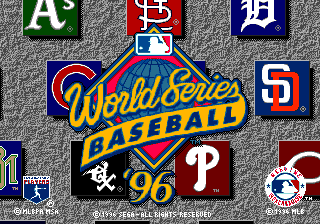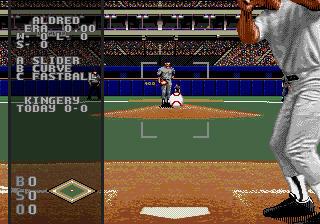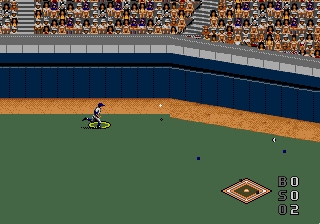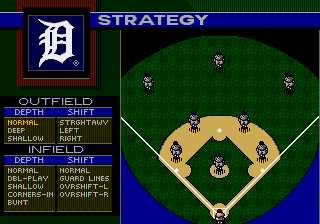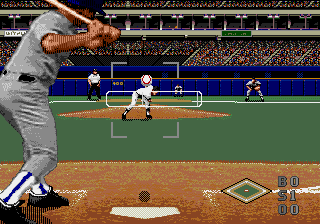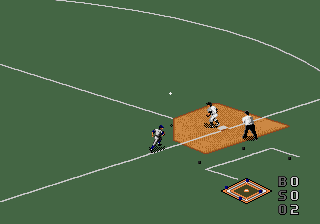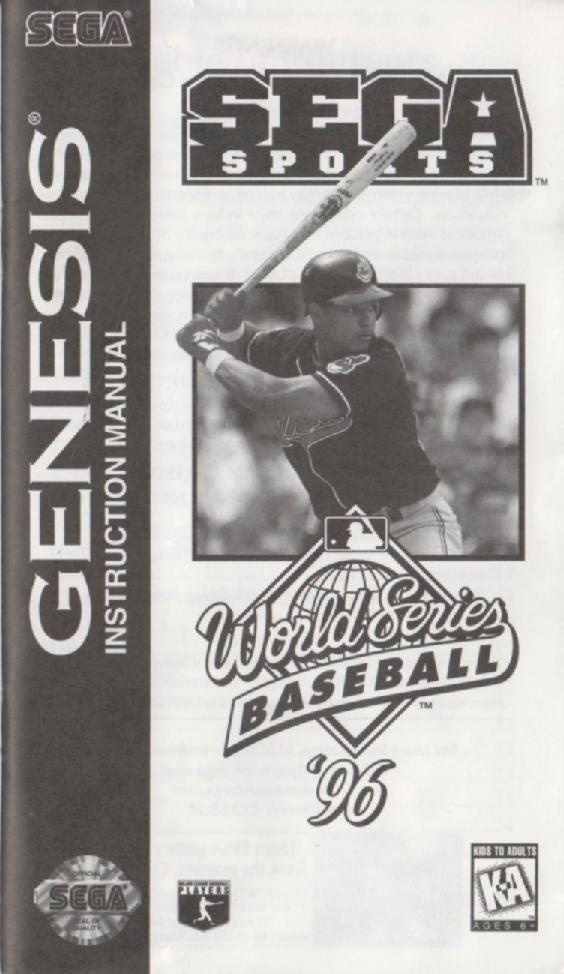Difference between revisions of "World Series Baseball '96 (Mega Drive)"
From Sega Retro
m (Text replacement - " Rey Alferez" to " Rey Alferez") |
m (Text replacement - " Chris Lucich" to " Chris Lucich") |
||
| Line 210: | Line 210: | ||
*'''Test Lead:''' [[Dave Paniagua]] | *'''Test Lead:''' [[Dave Paniagua]] | ||
*'''Assistant Lead Tests:''' [[Lorne Asuncion]], Danny Dunn, Matt Prescott | *'''Assistant Lead Tests:''' [[Lorne Asuncion]], Danny Dunn, Matt Prescott | ||
| − | *'''Testers:''' [[Rey Alferez]], Don Carmichael, Marc Dawson, Mike Dobbins, Scott Farrar, Sam Ford, John Fosnaugh, Chris Garrett, Rob Hernandez, Roderick Hong, Christina Hurley, Ryan Hurth, Matt Ironside, [[Jeff Junio]], Ian Levin, Chris Lucich, Matt Lucich, Tony Lynch, Conner Morlang, Darren Nagtalon, Raul Orozco, Sean Potter, Tony Ragano, Ben Rubright, Len Sayers, Kathleen Silkworth, Jeff Silveria, Tim Spengler, Brian Thoroman, Ferdinand Villar, Pat Walsh, Jeremy Wheat, Charlie Yang, Peter Young | + | *'''Testers:''' [[Rey Alferez]], Don Carmichael, Marc Dawson, Mike Dobbins, Scott Farrar, Sam Ford, John Fosnaugh, Chris Garrett, Rob Hernandez, Roderick Hong, Christina Hurley, Ryan Hurth, Matt Ironside, [[Jeff Junio]], Ian Levin, [[Chris Lucich]], Matt Lucich, Tony Lynch, Conner Morlang, Darren Nagtalon, Raul Orozco, Sean Potter, Tony Ragano, Ben Rubright, Len Sayers, Kathleen Silkworth, Jeff Silveria, Tim Spengler, Brian Thoroman, Ferdinand Villar, Pat Walsh, Jeremy Wheat, Charlie Yang, Peter Young |
*'''Sega Sports Team:''' [[Chris Cutliff]], [[Gerald DeYoung]], [[Rosie Freeman]], [[Tracy Johnson]], [[Scott Rohde]] | *'''Sega Sports Team:''' [[Chris Cutliff]], [[Gerald DeYoung]], [[Rosie Freeman]], [[Tracy Johnson]], [[Scott Rohde]] | ||
*'''Marketing:''' [[John Gillin]], [[Anne Moellering]], [[Christine Nunn]] | *'''Marketing:''' [[John Gillin]], [[Anne Moellering]], [[Christine Nunn]] | ||
Revision as of 16:45, 15 April 2024
| World Series Baseball '96 | ||||||||||
|---|---|---|---|---|---|---|---|---|---|---|
| System(s): Sega Mega Drive | ||||||||||
| Publisher: Sega | ||||||||||
| Developer: BlueSky Software | ||||||||||
| Licensor: Major League Baseball Properties, Major League Baseball Players Association | ||||||||||
| Sound driver: GEMS | ||||||||||
| Peripherals supported: Six Button Control Pad | ||||||||||
| Genre: Sports (baseball) | ||||||||||
| Number of players: 1-2 | ||||||||||
|
World Series Baseball '96 is a baseball game in Sega's World Series Baseball franchise. The game is a roster update to World Series Baseball '95. It was released exclusively for the Sega Mega Drive in North America. A PC version was planned[5], but cancelled.
Contents
Gameplay
The game plays identically to World Series Baseball '95 for the Sega Mega Drive. It features all 28 teams and 700 players from the 1996 MLB season, along with all 28 ballparks. The game additionally features several special teams: the American League Stars, National League Stars, and MLB Stars (consisting of the best players from each league or from both leagues) and the American League Legends, National League Legends, and MLB Legends (all-star teams including historical players such as Babe Ruth).
- Exhibition: A single game against a human or computer player. The player can also watch two computer-controlled teams play. Assigning control to a human is done before the game by moving the player to a team with
 or
or  , then the game is started with START .
, then the game is started with START . - League: Plays a season of games that culminate in the World Series. The player can choose the number of games (13, 26, 52, 104, or a full 162 games) and the number of divisions (4 or 6). The game has the ability to draft and trade players. There is a mid-season All-Star Game whose members are chosen based on the player's season. The game uses a battery backup to save the player's progress.
- Playoffs: A truncated season with only the play-offs. Progress in this mode is also saved using the battery backup.
- Batting Practice: The player practices batting. There are no outs in this mode. The player can select a left- or right-handed pitcher, a left- or right-handed batter, the type of pitch, and the venue.
- Home Run Derby: Players have 10 attempts to hit as many home runs as possible. A missed attempt is a hit that is not a home run; there are no strike-outs. This mode can be played by up to 8 players taking turns.
- Classic Home Run Derby: This mode is a home run competition that retains outs and innings. Like a standard baseball game, the player pitches during one half of the inning and hits in the other half, but there is no fielding or baserunning. The player with the most home runs after nine innings is the winner. It can be played by one or two players.
The scoreboard is shown at the beginning of the game and after each play (and can be shown by calling a time-out with START ). The scoreboard has a menu that allows players to set the batting line-up, change the defensive position of each player, and choose the starting and relief pitchers. Starting pitchers have more stamina than relief pitchers, but players can have up to two relievers warm up to their maximum stamina in the bullpen. The scoreboard also provides options including selecting the difficulty for pitching and batting separately (Rookie, Veteran, or All-Star), setting the length of the game (3, 6, or 9 innings) before the first pitch, and toggling auto-fielding.
Teams
| League | Division | Team | Players |
|---|---|---|---|
| American | Western | ||
| Central | |||
| Eastern | |||
| National | Western | ||
| Central | |||
| Eastern | |||
Production credits
- Developed by: BlueSky Software
- Game Design: Chuck Osieja, Jay Panek, Dana Christianson
- Producer: Chris Smith
- Assistant Producer: David Perkinson
- Product Manager: Brad Hogan
- Lead Artist: Scott Seidel
- Artists: Rick Randolph, John Seidel, Joe Shoopack, Drew Krevi, George Simmons, Ray Ferro, Phil Gordon, Brian McMurdo, Chris Kreidel, Amber Long, Dok Whitson, Geoff Knobel
- Lead Programmer: David Dentt
- Programmers: Bill James, Larry Claque, Kevin Baca, Mike Nana, Dave Kunkler
- Sound, Speech, and Music: Sam Powell
- Voice Talent: Steve Mollenhauer, Tim Stavlor, Scott Seidel, Chuck Osieja, Jay Panek, John Holland
- Manual: T.S. Flanagan
- Test Lead: Dave Paniagua
- Assistant Lead Tests: Lorne Asuncion, Danny Dunn, Matt Prescott
- Testers: Rey Alferez, Don Carmichael, Marc Dawson, Mike Dobbins, Scott Farrar, Sam Ford, John Fosnaugh, Chris Garrett, Rob Hernandez, Roderick Hong, Christina Hurley, Ryan Hurth, Matt Ironside, Jeff Junio, Ian Levin, Chris Lucich, Matt Lucich, Tony Lynch, Conner Morlang, Darren Nagtalon, Raul Orozco, Sean Potter, Tony Ragano, Ben Rubright, Len Sayers, Kathleen Silkworth, Jeff Silveria, Tim Spengler, Brian Thoroman, Ferdinand Villar, Pat Walsh, Jeremy Wheat, Charlie Yang, Peter Young
- Sega Sports Team: Chris Cutliff, Gerald DeYoung, Rosie Freeman, Tracy Johnson, Scott Rohde
- Marketing: John Gillin, Anne Moellering, Christine Nunn
- Special Thanks: John Carlucci, Tom Carrol, Tom Dipace, James Doval, Angela Edwards, Sean Hennessy, Michael Kramer, Mark Lorenzen, Willie Mancero, Matt McDonald, Mike McMahon, Joe Miller, Tom Moon, Mark Paniagua, Steve Payne, Karl Robillard, Helene Sheeler, Matt
Magazine articles
- Main article: World Series Baseball '96 (Mega Drive)/Magazine articles.
Physical scans
| Sega Retro Average | |||||||||||||||||||||||||||||||||||||||
|---|---|---|---|---|---|---|---|---|---|---|---|---|---|---|---|---|---|---|---|---|---|---|---|---|---|---|---|---|---|---|---|---|---|---|---|---|---|---|---|
|
| 74 | |
|---|---|
| Based on 7 reviews | |
Technical information
- Main article: World Series Baseball '96 (Mega Drive)/Technical information.
References
- ↑ https://groups.google.com/g/rec.games.video.sega/c/fBWxpxsPS-g/m/JKwXLqcGR2AJ
- ↑ http://sega-saturn.com/july-n.htm (Wayback Machine: 1996-12-15 06:05)
- ↑ 3.0 3.1 GamePro, "September 1996" (US; 1996-xx-xx), page 88
- ↑ Press release: 1996-05-16: ALL-STAR LINE-UP OF SEGA SPORTS VIDEOGAMES EXPANDS THE PROVEN TOP-SELLING FRANCHISE
- ↑ GamePro, "December 1996" (US; 1996-xx-xx), page 102
- ↑ File:World Series Baseball 96 MD US Manual.pdf, page 22
- ↑ 1700 igr dlya Sega, "" (RU; 2001-xx-xx), page 342
- ↑ Game Players, "Vol. 9 No. 9 September 1996" (US; 1996-08-06), page 84
- ↑ Game Informer, "August 1996" (US; 1996-0x-xx), page 22
- ↑ Next Generation, "September 1996" (US; 1996-08-20), page 162
- ↑ Tricks 16 bit, "Tricks Sega Gold 800 igr" (RU; 1998-03-20), page 298
- ↑ VideoGames, "September 1996" (US; 1996-08-20), page 77
| World Series Baseball '96 (Mega Drive) | |
|---|---|
|
Main page | Hidden content | Magazine articles | Reception | Region coding | Technical information | |
| Games in the World Series Baseball Series | |
|---|---|
| World Series Baseball (1994) | World Series Baseball '95 (1995) | World Series Baseball '96 (1996) | World Series Baseball 98 (1997) | |
| World Series Baseball (1993) | World Series Baseball '95 (1994) | Nomo's World Series Baseball (1995) | |
| World Series Baseball Starring Deion Sanders (1995) | |
| World Series Baseball (1995) | World Series Baseball II (1996) | World Series Baseball 98 (1997) | |
| World Series Baseball '96 (1996) | |
| World Series 99 (1999) | World Series Baseball (2001) | |
| World Series Baseball 2K1 (2000) | World Series Baseball 2K2 (2001) | |
| World Series Baseball (2002) | World Series Baseball 2K3 (2003) | |
| World Series Baseball related media | |
| Prima's Official Strategy Guide: World Series Baseball 2K1 (2000) | |
- Six Button Control Pad-compatible games
- 1-2 player games
- US Mega Drive games
- All US games
- Mega Drive games
- 1996 Mega Drive games
- All 1996 games
- Mega Drive baseball games
- Mega Drive sports games
- All sports games
- All games
- Missing baseball logo
- World Series Baseball '96 (Mega Drive)
- World Series Baseball (franchise)
